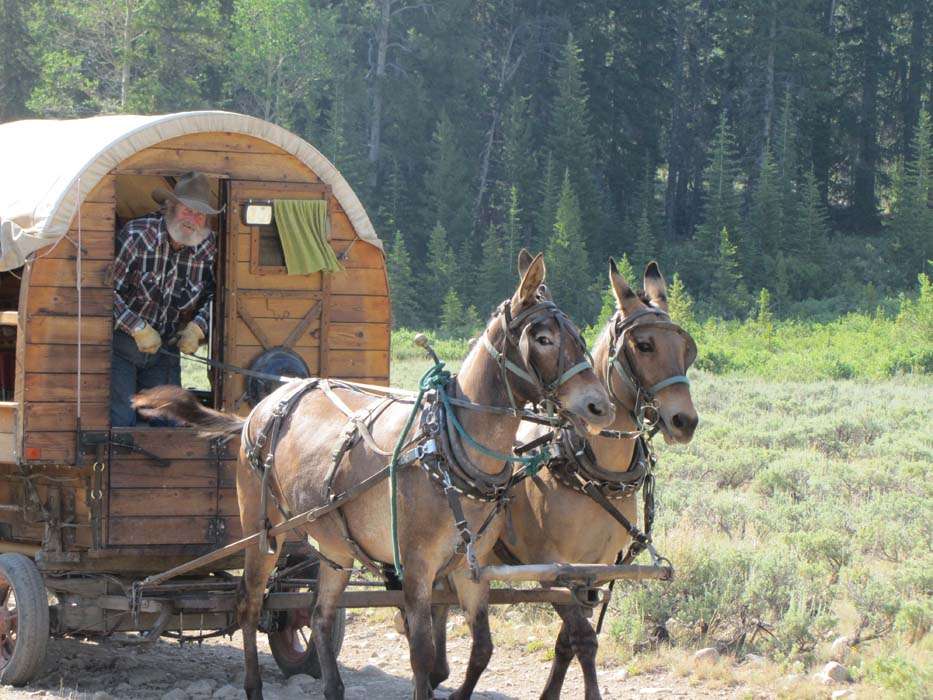No products in the cart.
Save Copper Basin

Five Guys Try to Enjoy Idaho the Right Way
Story and Photos by Mahlon Kriebel
“Bandi! Bucx!” Lloyd Warr’s call drifted through a curtain of fog tangled in the sagebrush, shrouding the morning sun. Obviously, his mules had bolted. I had met Lloyd the previous day, when he arrived at Lake Creek Camp. He said he lived in Rupert and he and his companions from Buhl belonged to the Idaho Draft Horse and Mule Association.
I had always thought mules were untrustworthy, but Lloyd explained that breeders select mares and jacks for temperament. Anyway, it was too early to rise, as my four friends and I on this trip into Copper Basin, in the Salmon-Challis National Forest, had talked well past our bedtime. The campfire, which had sealed us in from the cold night, had burned out, and none of my rough-and-tough storytellers had emerged to start the fire. “Bandi, Bucx …” receded as Lloyd made his way along the Copper Basin Loop Road.
“Bandi, Bucx … hay, oats.” Pulling on my boots, I decided to help. Ron had just begun to prepare coffee and Quint was kindling the fire. I called, “Breakfast can wait,” and gunned my off-road vehicle (ORV) towards the voice. To the west, Standhope Peak and Big Black Dome, both rearing nearly 3,500 feet above the basin floor, were pink and red in the morning glow of lifting fog. Driving up alongside Lloyd, I asked, “Can I help?”
Lloyd, about my age, seventy something, replied, “Damn mules, they’ve never bolted.”
I knew we could drive cross-country and, with luck, catch the feckless mules. “Hop on.”
Lloyd hesitated. “I’ve never been on one of these contraptions.”
“Well, this ain’t an ordinary ORV. It’s equipped with a passenger seat.”
This content is available for purchase. Please select from available options.
Purchase Only
Purchase Only
Dr. Kelly Cassidy, curator of the Washington State University Connor Museum, just recently found the pigmy rabbits and green-tailed towhees I had stuffed all those years ago. The skins still look good, reflecting the care demanded by Prof. Hudson. Of course, the arsenic would have killed any moth maggots. The pigmy rabbit and green-tailed towhee study skins will remain for centuries, but will the fragile ecosystems of Copper Basin withstand overgrazing and the onslaught of off-road vehicles? How many wolf packs can the basin support? Could bison be reintroduced?
Perhaps I must give up my ORV and the rancher must decrease his herd. One thing is for sure: compromise is imperative.
The Wolf Man Speaks
I recently attended a presentation by Carter Niemeyer, retired Idaho Wolf Recovery Coordinator [for a story on Niemeyer’s work, see “Boundary Lines” IDAHO magazine, March 2011], who also participated in the reintroduction of wolves into Yellowstone National Park. Carter understands wolves and is sensitive to the need for compromise among ranchers, hunters, and the public to reach a viable solution to wolf predation. He said given that wolves increase by twenty-four percent annually, and the abundance of prey (elk, deer, cattle, and sheep), the wolf population is on a steep growth curve. They are here to stay. His solution is management. He said Idaho’s government wants 152 wolves, but there are more than 700 in the state. Once a compromise number is reached, he said that number must be maintained by hunting. In 2012, 342 wolves were killed in Idaho. Wolves are fecund such that the excess—twenty-four percent of the agreed number—should be eliminated every year. — Mahlon Kriebel
[/private]

